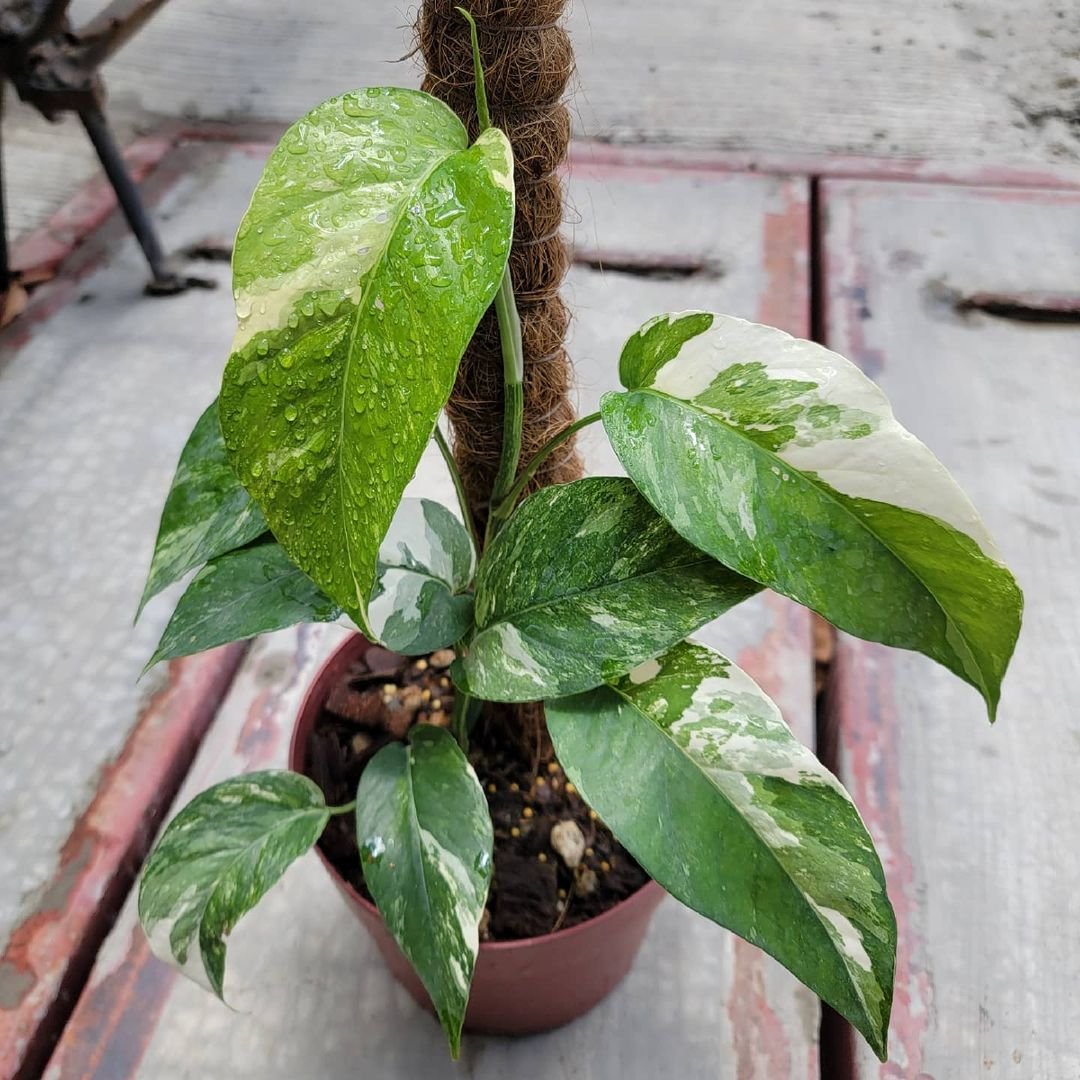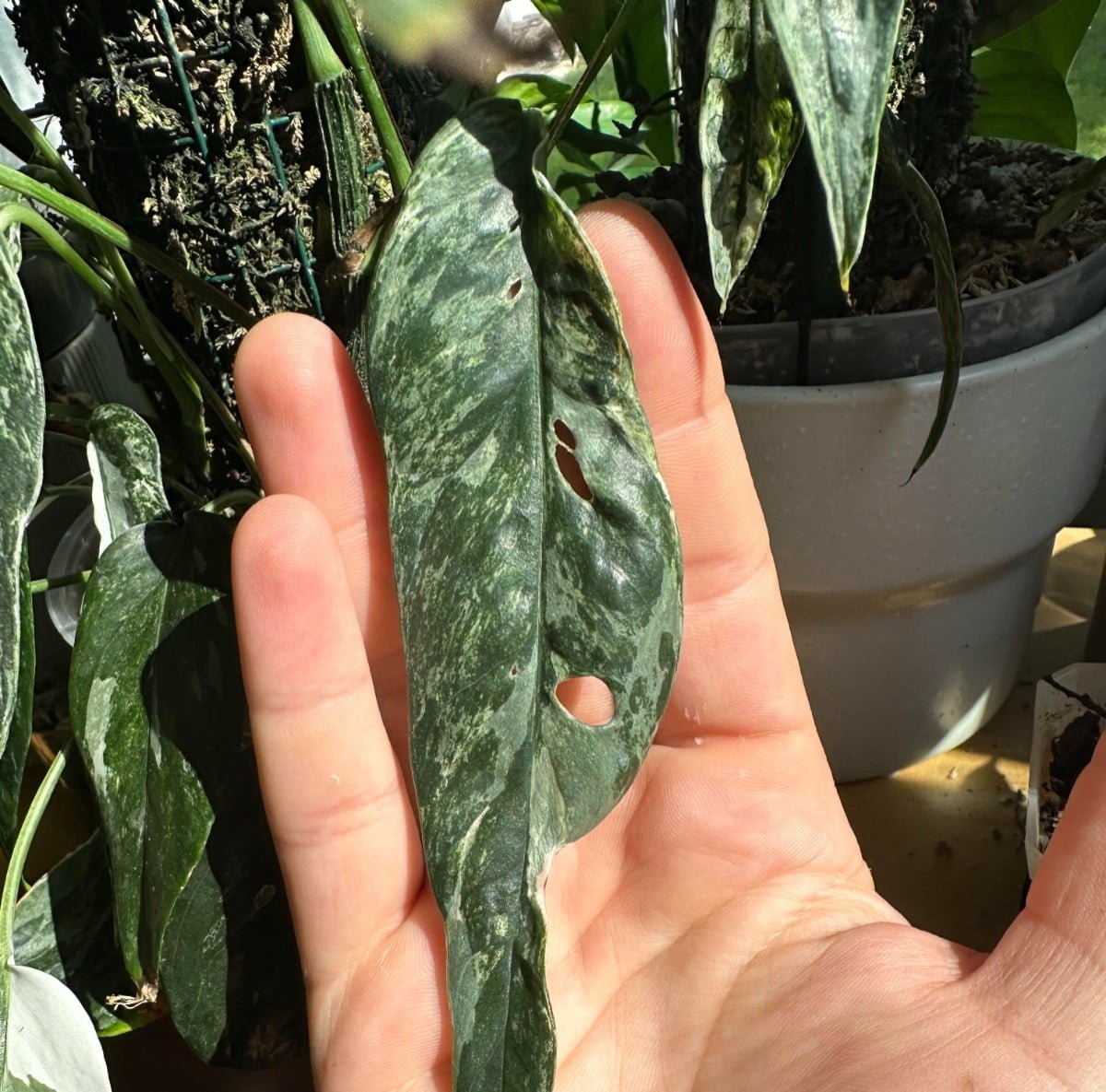In the world of houseplants, few specimens can match the elegance and allure of Epipremnum pinnatum ‘Albo-Variegata.’ With its striking green and white variegated leaves that develop charming fenestrations as the plant matures, it’s no wonder this pothos variety has earned a reputation as one of the rarest and most coveted cultivars among plant enthusiasts. In this comprehensive care guide, we’ll delve into every aspect of caring for this exquisite botanical wonder, equipping you with the knowledge and expertise needed to ensure your variegated pothos thrives in its new home.
What Is Epipremnum Pinnatum ‘Albo-Variegata’?

Here’s a concise chart with information about Epipremnum pinnatum ‘Albo-Variegata’:
| Attribute | Information |
|---|---|
| Botanical Name | Epipremnum pinnatum ‘Albo-Variegata’ |
| Plant Type | Vine |
| Soil Type | Well-draining, rich potting mix |
| Color Varieties | Green with white variegation |
| Zones | 10-12 |
| Exposure | Bright, indirect light to partial shade |
| Bloom Time | Rarely flowers |
| Height/Spread | Can climb up to several feet, spread varies |
Before we dive into the intricacies of care, let’s get to know our star plant a little better. Epipremnum pinnatum ‘Albo-Variegata’ is a naturally occurring mutation of the Dragon Tail pothos. This tropical vine undergoes a mesmerizing transformation as it matures. In its juvenile stage, its leaves are narrow and oval-shaped, adorned with delightful marbling in shades of chartreuse, mint green, and white. However, as the plant reaches maturity, the leaves truly come into their own. They develop Monstera-like fenestrations, well-defined white or cream splashes, and a silvery-green marbling that is nothing short of captivating. Occasionally, this plant surprises with entirely white leaves, a sight to behold but with a limited lifespan as they may develop brown spots after a few months.
Epipremnum Pinnatum Albo Care Guide

Caring for your Epipremnum Pinnatum ‘Albo-Variegata’ may initially seem like a daunting task, particularly considering its price tag. But fret not, for this is still a pothos plant at heart, and it’s not as finicky as its rare status might suggest. Here’s a breakdown of the essential care requirements:
Light
Light is the lifeblood of your variegated pothos. It thrives in bright indirect light, which not only showcases its variegated leaf patterns but also promotes healthy growth. Position your plant in a room facing east or west, approximately 2 to 3 feet away from the window. However, avoid direct sunlight, as it can lead to unsightly brown, dry patches. Unlike other pothos varieties, this one doesn’t tolerate low light conditions well and will slowly revert to plain green leaves if kept in a dimly lit space.
Soil
Choose a well-draining, nutrient-rich potting mix for your Epipremnum Albo. An easy recipe for success includes equal parts universal potting soil, orchid bark, and perlite or pumice. Alternatively, you can incorporate coco coir into the mix to enhance root aeration, drainage, and moisture retention. Just remember to supplement it with worm castings for the necessary nutrients.
Water

Moderate watering is the key to keeping your Epipremnum pinnatum Albo happy. Allow the top 2 inches (5 cm) of soil to dry out before giving your plant a thorough soak. Always check the soil with your finger before reaching for the watering can to prevent overwatering, which can lead to issues like root rot or pest infestations. Adjust your watering schedule based on the season and indoor conditions, giving more water during hot summer months and reducing frequency during winter. Light levels also play a role in determining your watering regimen.
Temperature
Maintain an ideal temperature range between 65°F and 85°F (18°C to 29°C) for your variegated pothos. This tropical plant is sensitive to frost and should be kept away from temperatures below 50°F (10°C) to prevent permanent root damage. If you live in USDA zones 9b to 12, you can grow it outdoors, but ensure it’s sheltered from direct sunlight to avoid leaf scorching.
Humidity
Aim to maintain a humidity level of around 60% for your Epipremnum Albo. This tropical plant thrives in humid environments, promoting faster and lusher growth while reducing the risk of spider mite infestations. Achieve higher humidity by using a humidifier, placing the pot on a pebble tray with water, or grouping it with other humidity-loving plants.
Fertilizer
Feed your pothos once a month during the growing season, from early spring to early fall. Opt for a balanced organic fertilizer with an N-P-K nutrient ratio of 10-10-10, following the label instructions and diluting the solution to avoid root damage. Keep in mind that your plant may grow slower during winter or in low-light conditions, so adjust your fertilization accordingly.
Pruning
Regularly trim your Epipremnum pinnatum when the vines become excessively long or if the plant starts to look leggy. Pruning not only maintains a pleasing appearance but also encourages the growth of new stems. Be sure to disinfect your scissors or pruning shears before each session to prevent the spread of fungi and bacteria.
Support

This pothos variety loves to climb, and the best way to facilitate its growth is by providing a sphagnum moss pole for it to cling to. As the plant climbs, it produces larger, deeply fenestrated leaves that enhance its overall beauty. Alternatively, if you prefer a trailing appearance, you can let it hang, though keep in mind that it won’t reach maturity, and its leaves won’t develop fenestrations.
Repotting
Plan to repot your Epipremnum Albo when it outgrows its current container, typically every 2 to 3 years. Choose a pot that’s one size larger or about 2 inches (5 cm) wider, but avoid going too big to prevent moisture retention issues that can lead to root rot. The material of the pot can vary, with plastic retaining moisture and terracotta wicking moisture from the soil, each requiring different watering schedules.
Epipremnum Pinnatum ‘Albo’ Propagation Guide

Propagation of your Epipremnum pinnatum Albo can be an exciting endeavor. The best method is to root stem cuttings, following these steps:
- Use a sharp, sterilized blade to cut a long vine into single-node sections.
- Fill a transparent plastic container with damp sphagnum moss, placing the cuttings on top of the moss.
- Cover the bottom of the cuttings with moss and place a lid on top of the container.
- Keep the container in a warm, well-lit location and regularly mist the moss to keep it damp.
Rooting times may vary, with highly variegated cuttings taking longer due to reduced chlorophyll production. Once roots reach at least 2 inches (5 cm) in length, you can transplant them into soil.
Another option is propagating using ‘wet sticks,’ which are stem sections with no leaves but an axillary bud and a small aerial root. The process is similar to regular cuttings, using sphagnum moss as the rooting medium.
Common Pests & Problems

Pests
While the Epipremnum pinnatum ‘Albo-Variegata’ is a stunning addition to your home, it can attract pests such as spider mites, thrips, mealybugs, and scale due to its high variegation. To keep these pests at bay, ensure your plant receives proper care, including adequate light, appropriate potting mix, and regular fertilization.
Brown Leaf Spots
The development of brown leaf spots can result from various factors, including bacterial infection, root rot, excessive direct sunlight, or over-fertilization. In some cases, the appearance of brown spots is a natural process as the plant redirects resources from white, non-chlorophyll-containing leaves. To maintain your plant’s aesthetics, trim the brown patches.
Leaves Turning Green
If your Epipremnum pinnatum ‘Albo-Variegata’ starts to lose its variegation and the leaves turn green, it’s a sign of unfavorable conditions. To prevent this, ensure it receives bright indirect light, fertilize during the growing season, and repot as needed.
In Conclusion
Caring for Epipremnum pinnatum ‘Albo-Variegata’ may seem intricate, but with the right knowledge and attention to detail, you can enjoy the rewards of nurturing this rare and exquisite plant. By providing the right balance of light, soil, water, and nutrients, you’ll be well on your way to cultivating a thriving specimen that’s sure to be the envy of any indoor garden. So, go ahead and embark on this botanical journey, and may your variegated pothos flourish in its new home. Happy gardening!
Pingback: Dracaena Angolensis: The Captivating Dragon Plant
Pingback: Variegated Monsteras: A Deep Dive into the Kings and Queens of Foliage